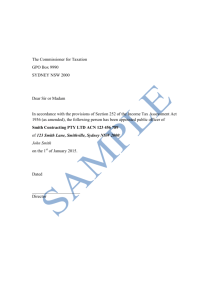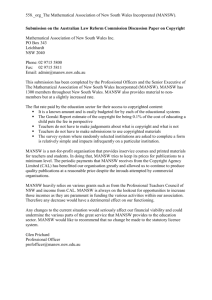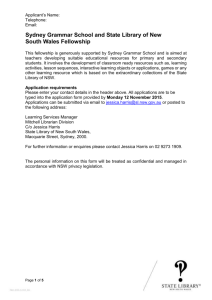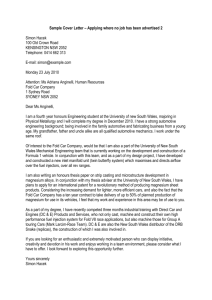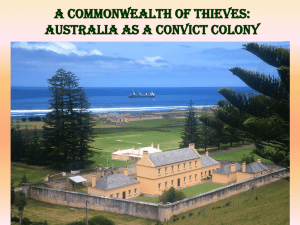the brochure - Reserve Bank of Australia Museum
advertisement
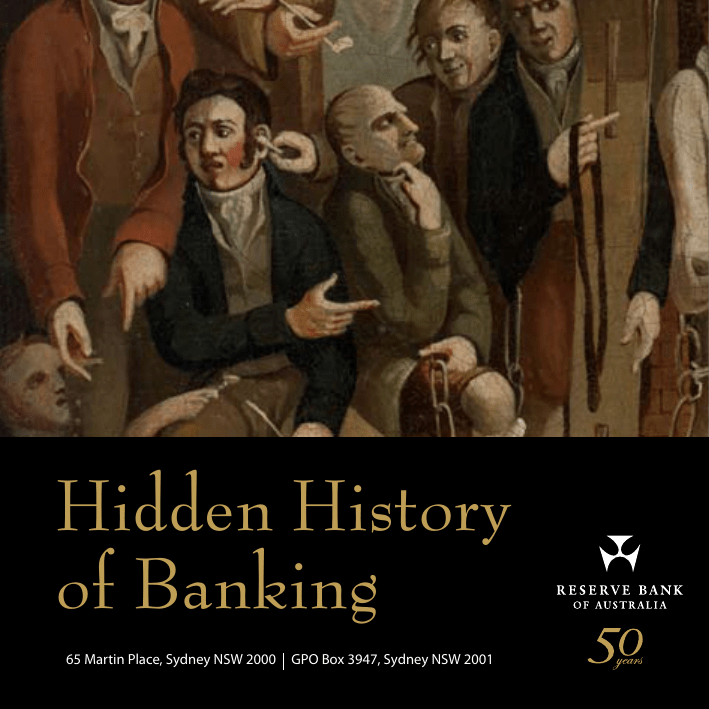
Hidden History of Banking 65 Martin Place, Sydney NSW 2000 GPO Box 3947, Sydney NSW 2001 Regulations of the New South Wales Saving Bank ... To which is prefixed a plain address to convicts on their arrival ... Sydney, printed by G. Howe Government Printer, 1819. Mitchell Library, State Library of NSW Notable Convicts The Reserve Bank of Australia is a custodian of colonial records, including records that document money belonging to convicts. Although convicts transported to New South Wales are often portrayed as penniless, they usually arrived in the colony with sums of money. Convicts were encouraged to lodge their money in one of the colony’s banks. In a pamphlet titled Address to convicts on their arrival …, Barron Field, Judge of the Supreme Court, offered the advice: ‘Many of you bring small Sums of Money from England, your own Savings or the Bounty of your Friends … Instead of trusting those Sums to any private Individual, you are recommended to place them in the public Saving Bank, at Mr Robert Campbell’s, senior, Merchant, in George-street, Sydney …’ Name Mary Ann Conway Age 20 years of age upon arrival in NSW Religion Roman Catholic Complexion Fair, ruddy and pockmarked skin Hair & eyes Brown hair and light blue eyes Particular marks or scars A raised dark mole on the right side of her chin and a scar on the back right side of her neck Calling Needle woman and house maid Education Able to read and write Where convicted Tried in Limerick, Ireland for stealing a cloak When convicted 1 January 1836 Sentence Transported to New South Wales for seven years; arrived on the ship Thomas Harrison, in 1836 Savings Deposited 2 pounds, 10 shillings and 7 pence in the Savings Bank of New South Wales. Worked at the Female Factory, Parramatta, a building designed by the convict, Francis Greenway. Granted permission to marry Benjamin Johnson, a convict tried for forgery, on 25 November 1840. Following the Report on Convicts of 1822 by Commissioner John Thomas Bigge, convicts were forced to lodge their money in the bank ‘till their condition was improved by their good behaviour, testified by their masters’ (Bigge Report). The Reserve Bank of Australia inherited the records of convicts’s balances from Campbell’s Bank. They document the names of convicts, the ships on which they arrived and their sums of money. The lives of two convicts have been highlighted in the display from these lists. Their characteristics may be contrasted with the general features drawn by Juan Ravenet in his portrait of convicts. Augustus Earle, A government jail gang, Sydney, N.S.Wales, 1830, lithograph. National Library of Australia Return of convicts’s balances for selected convicts arriving on ships between 1826 and 1840, Savings Bank of New South Wales. Reserve Bank of Australia Ref 5-1-10-1 Juan Ravenet, Convicts in New Holland, 1793 wash drawing made on the Spanish Scientific Expedition of Alessandro Malaspina, 1789–94. Mitchell Library, State Library of NSW Name Abel Smith Age 50 years of age upon arrival in NSW Religion Protestant Height 5ft 7 inches tall Hair & Eyes Dark brown to grey hair, and hazel eyes Family Married with six children Where convicted Tried in Nottingham Town When convicted 19 March 1827, and sentenced for life Former convictions Two former convictions Sentence Transported to New South Wales on 11 June 1827 from Kent on the ship Prince Regent, and arrived 27 September 1827 Savings Deposited 1 pound,10 shillings and 6 pence in Campbell’s Bank. Transferred to Moreton Bay (now Brisbane) in 1828, a separate penal settlement that housed some of Sydney’s worst convicts. Prisons, Misery and Money In 1812, Francis Greenway awaited trial for forgery in Newgate Prison, Bristol, where he is thought to have painted two scenes of the prison yard. He was transported to the penal colony of New South Wales in 1814, and received the patronage of Governor Macquarie to become one of the colony’s most prominent architects. Greenway’s paintings of Newgate Prison articulate the building’s details in two different conditions of light. The convicts’s hands form gestures like the links of a chain as they indicate varying incidents. While the mock trial proceeds, fresh crimes are committed by the thieving characters on either side of the picture. In the companion painting, prisoners play cards; others beg for food while fellow-inmates eat. (left & overleaf ) Francis Greenway, The Mock Trial, 1812, oil on canvas (details). Mitchell Library, State Library of NSW Francis Greenway is thought to be the figure in the blue tailcoat. In the scene of the mock trial, his ear is being tickled to distract him from the theft of his pocket watch. He is shown with an official in the other painting, possibly reporting the crime, as a pocket watch is dangled above the card game. Like other prisons in Britain, the Bristol gaol was privately operated and prisoners needed to pay for their imprisonment. They were housed according to their ability to pay, ranging from a private cell with a cleaning woman to lying on the floor with no cover. Prisoners could also pay to have lighter manacles fitted. ‘Nothing could be more offensive or melancholy’ than the Bristol prison, wrote Thomas Fowell Buxton in An Inquiry, whether crime and misery are produced or prevented by our present system of prison discipline (1818). He describes the prison yard as exhibiting ‘vice in all its stages; boys intermingle with men; the accused with the convicted; the venial offender with the veteran and the atrocious criminal.’ The majority of prisoners were ‘in rags – almost all were filthy in the extreme’ with an ‘indescribable stench.’ Francis Greenway, Scene in Newgate Prison, Bristol, 1812, oil on canvas (detail). Mitchell Library, State Library of NSW Great Expectations Convicts transported to New South Wales were not imprisoned in gaols, but were assigned to different jobs and labours. They could earn privileges for completing extra work, and they were free to work and to earn money once a ticket of leave or pardon was granted. The system presented convicts with the opportunity of transforming their lives. Charles Dickens adapted aspects of the colony’s convict system in his novel, Great Expectations (1860-61). The novel’s hero, Pip Pirrip, believes that his income derives from the reclusive Miss Havisham; however, he discovers with amazement that it comes from Abel Magwitch, a convict whom he once assisted. After his transportation to New South Wales, Magwitch amassed a fortune. ‘The blood horses of them colonists might fling up the dust over me as I was walking …When one of ’em says to another, ‘He was a convict, a few year ago, and is a ignorant common fellow now, for all he’s lucky’…’ Abel Magwitch, from Charles Dickens, Great Expectations, Volume 2, Chapter 20 Excerpts from A.W. Sandberg’s silent film version of Great Expectations (1922) have been edited for the exhibition. The film opens with the orphan Pip visiting the graves of his parents. He encounters the escaped convict, Magwitch, who materialises like a disgruntled ghost. (above) Norman Lindsay’s illustrated edition of Charles Dickens’s Great Expectations, Shepherd Press, Sydney, 1947. The illustration shows Pip Pirrip standing between Abel Magwitch and Miss Havisham, representing the two possible sources of his wealth. (left) Still image of Pip (Martin Hertzberg) from Store forventninger [Great Expectations], 1922. Courtesy of Nordisk Film Production, Denmark. The convict forces him to promise that he will bring food and a file to break his chains. Pip dreams that Magwitch threatens him violently, and the next day he returns with the promised goods. Magwitch is later recaptured and transported to the penal colony in New South Wales. Pip is a gentleman living in London when Magwitch suddenly reappears, and reveals that he acquired wealth in New South Wales after serving his sentence. He has been the secret source of Pip’s income. In reality a number of emancipists, or freed convicts, became very wealthy citizens, including Mary Reibey and Samuel Terry who left a personal estate of £ 250,000 and property that included the land now occupied by Martin Place, Sydney. Still images from Store forventninger [Great Expectations], silent film version made in Denmark, 1922. (left) Pip dreams that the convict roasts his heart and liver. Courtesy of Nordisk Film Production, Denmark. James Burrow: the woman on the $20 note The Regulations of the New South Wales Saving Bank (1819) encouraged settlers to abstain from the temptations of gambling and alcohol lest they remain ‘poor, vicious, and unmarried’. It deemed that ‘those recent and laudable Institutions of the Mother Country, called a Saving Bank’ may generate ‘Habits of Economy, Industry and Matrimony.’ Mary Reibey (1777-1855) is portrayed on the $20 note. She was born in Bury, Lancashire, England, and was charged at the age of 13 with stealing a horse while disguised as a boy under the assumed identity of James Burrow. She remained in this disguise until her trial. Savings Bank of New South Wales, ledger of accounts, 1832-1842, showing the account entry for Mary Reibey. Reserve Bank of Australia Ref 5-1-1-1 ‘… no one will do well that is not thrifty Correct and Sober. [T]his place is not like England you are under the Eye of every one and your Character Scrutinized by both Rich and poor …’ Mary Reibey, letter to her cousin, Alice Hope, 1818 Mary Reibey was sentenced to seven years transportation to the colony of New South Wales. She arrived in 1792 and was assigned as a nursemaid to the family of Major Francis Grose. Mary married Thomas Reibey two years later, and after his early death, she continued his trading business with considerable prosperity. Despite her success, Mary Reibey remained sensitive to her convict origins, and is believed to have altered records to disguise this fact. Miniature portrait of Mary Reibey, c.1835, watercolour on ivory. The portrait is the basis of her representation on the $20 note. Mitchell Library, State Library of NSW Section of George Street, Sydney from Joseph Fowles, Sydney in 1848, showing buildings once owned by Mary Reibey (R.Lamb to N.Bushby). National Library of Australia Unknown artist, portrait of Francis Greenway, pencil drawing; possibly a self-portrait. Mitchell Library, State Library of NSW Francis Greenway: a fraudulent life Francis Greenway (1777-1837) was portrayed on the $10 note in the first series of decimal currency notes issued in 1966. Greenway was an architect in Bristol, England, who was charged with forgery and transported to New South Wales in 1814. Greenway was appointed Acting Civil Architect in 1816 by Governor Lachlan Macquarie and completed buildings that still stand in Sydney, including St James’s Church, King Street (1819-24), the Convict Barracks, Hyde Park (1817-19), and the stables to Government House (1817-21), now incorporated into the Sydney Conservatorium of Music. Ironically, the $10 note which portrayed Francis Greenway was itself the object of counterfeiting when it was introduced in 1966. (left) George Evans (?), Convict Barrack, Sydney, N.S.Wales. c.1820, watercolour (detail). Mitchell Library, State Library of NSW (below) Robert Russell, St. James’ Church, Supreme Court House, Sydney, printed by J.G. Austin, 1836, lithograph (detail). National Library of Australia (rear cover) Francis Greenway, Plan and elevation of the Governor’s stable and offices at Sydney, New South Wales, 1820, ink and wash drawing. Mitchell Library, State Library of NSW Hidden History of Banking: Notable Convicts, The Museum of Australian Currency Notes Reserve Bank of Australia © 2010. For further information concerning the museum please visit: www.rba.gov.au Curated by the Reserve Bank of Australia Curator: John Murphy Research Assistant: William Goodfellow Exhibition and Graphic Design: Freeman Ryan Design ISBN: 978-0-9807068-5-7 65 Martin Place, Sydney NSW 2000 GPO Box 3947, Sydney NSW 2001

